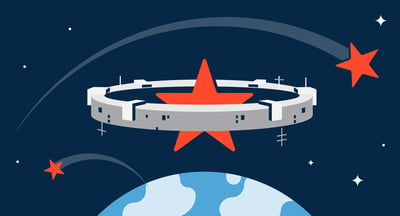November 14, 2019
 by Kelsey Norris / November 14, 2019
by Kelsey Norris / November 14, 2019

Since the beginning of G2, back when we were known as G2 Crowd, our mission was to bring transparency to B2B software purchasing in the form of reviews.
With that in mind, it’s obvious that reviews fuel the rocket ship that moves us as G2. But reviews don't always come organically — most of the time, our team had to ask for them.
| This is part 2 of 1,000,000 Unbiased Reviews: How We Did It. |
You may be wondering, how on Earth did they get to 1 million reviews? Honestly, so are we.
A huge part of it was our email marketing strategy. As any good email marketer will tell you, the real opportunity for us was growing and cultivating our user list, while simultaneously understanding their motivation to join G2. Then, the number of reviews generated provided a natural starting point to articulate a success metric, and ultimately, a conversion point to aim for.
G2 has an array of resources to offer. You can read expert content curated by our marketing and research teams, utilize our compare tools, and even write a review for a gift card or donation. People find G2 from all over, and we also help them find us by using paid social ads, vendor-run campaigns, and at marketing events.
The point is, we need to manage all of these people to meet their expectations in different ways. Engaging our users with the content they want makes them stick around longer and find more value.
We take our calls to action in emails very seriously because we have users looking to contribute a review for all kinds of reasons. They may want to help other professionals make better buying decisions, or they could just be looking for that free cup of coffee. Part of our segmentation includes handing specific users off to our marketing team, or running industry-specific tests for our Research content. It’s our job to make the user’s experience as tailored to them as possible.
We've all heard that first impressions matter. That's because they do, especially when it comes to email.
We've gone through many iterations of the Welcome Email during my time here at G2. Starting with a lovely letter from our CEO, evolving to an email with more company branding, all the way to its current iteration where we guide users to self-selected content based on their persona type: vendor, reviewer, or buyer.
Whichever option they choose has curated content that we follow-up with to help users continue on their own G2 journey.

The next essential piece in our email strategy is transactional emails.
Transactional emails are sent to users based on a behavior they take on the site. Our most common transactional email types are those that notify a user when their review has been rejected or approved, but we also have emails for password resets, lead submission confirmations, login info, and many more.
We strive to make sure the data we provide in these transactional emails is timely, accurate, and relevant.
Let’s flash back to our success metric: reviews. The majority of emails we send are in our promotional campaigns asking for reviews.
However, there are other steps before a recipient hits that “Submit Review” button after opening an email. We pay close attention to every single step along the way.
Here’s where A/B testing really comes in handy. The most important thing to keep in mind is, “What am I measuring?” Optimizing subject lines, button colors, copy, and creative are all small parts that improve the whole user experience.
While we’ve had glorious wins in the past, we’ve also learned some valuable lessons along the way, the most important of which is to keep reiterating on what we’re delivering. We’ve tested subject lines such as “10,000 pennies for your thoughts” (a clerical error on our part-we were only offering a $10 gift card) and we’ve tried to make emojis work (proving the poop emoji just doesn’t work for everyone).
We’ve pulled off some wildly creative content working with our data team to build out visual graphs in our Year in Review email. Sometimes, it’s as simple as getting a birthday wrong, and engaging with our users in a playful way. All of these seemingly small tests have evolved our email templates over the years, and I can confidently say for the better.
I would not be doing my due diligence to our email strategy if I did not mention one of the most challenging, but rewarding, obstacles I’ve faced during my time at G2… twice.
Migrating email service provider (ESP) tools.
If you find yourself going through this process, all I can say is have faith. Like most challenges, it seems more overwhelming than it is. As a rule of thumb, the most important thing is to stay on the same page as your development team at all times!
This is so important because the second most critical thing is building out the data requirements for your new platform. When building out our requirements, we included questions like:
As you’re imagining, this process involved a lot of shared spreadsheets, and even more communication. It’s like the old saying goes, “measure twice, cut once.” Only in this case it’s “check your data twice, implement once.” Having a good project manager on the team to keep everyone on pace and track followup items was crucial for us during both these processes.
|
TIP: Interested in using email marketing services to supplement your business outreach? Explore the best options out there: |
Personalization is what I like to refer to as the FName affliction. Every email marketer knows how to put a custom tag in their email that references the recipient's first name: “Hi Clara, We’d really like you to leave a review.”
Personalization is critical to our email strategy, because we want the user to feel important, but we wanted to stop relying on just FNAME. So we started testing user images in the banners to improve how we personalized our emails to each user.
As you can see, personalization is essential in making our users feel special, but to really upgrade our email marketing strategy we use customization.
Customization, for us, is understanding our users at many dynamic levels, and that’s where timely, accurate and relevant messaging comes in. We tailor messaging at the beginning of the user experience based on which channel they came in through. We collect data such as job title so we can direct users to categories of software related to what they’re most likely using. We’re now engaging with our users using different types of content such as video reviews and Q&A. We use our data to ask users to participate in discussions about the products they’ve already reviewed or indicate they use.
Customization for us isn’t going on autopilot and including FName, but it’s using data in a way that consistently surprises and delights our users.
Email has been one of the most impactful channels for G2’s growths, and also evolved into a passion for me. Setting up clear goals and optimizing each step of the process has allowed us to fine-tune our user experience. Challenges like switching up ESP tools, leaning into customization, transactional emails, and welcome series should be viewed as opportunities, not obstacles in your email strategy.
All of these aspects of email marketing have become essential nuts and bolts on our rocket ship to 1 million reviews.
Kelsey is a Marketing Manager who questions why people do what they do to pinpoint how to grab their attention. She has spent the last two years at G2 building a successful email and digital marketing strategy. An Indiana native, she has a BA in Marketing and MIS from Butler University. In her free time, Kelsey enjoys grabbing dinner at the latest restaurant in Chicago with friends or playing a quick hand of euchre.
You would never believe the things we were doing just a few years ago to get reviews.
 by Jed Fudally
by Jed Fudally
At the center of every (successful) tech company is one core principle: disruption.
 by Gina Carr
by Gina Carr
You would never believe the things we were doing just a few years ago to get reviews.
 by Jed Fudally
by Jed Fudally
At the center of every (successful) tech company is one core principle: disruption.
 by Gina Carr
by Gina Carr



